I love the displays at the Museum of Natural History. They're really great. Very Victorian. I love the craft involved in stuffing the animals (or making them from scratch) and making fake trees and rocks, and I love the trompe l'oeil paintings of the more distant surroundings. I love how dim and musty the museum is, with all its little nooks and crannies, and even love speculating on what it must be like to design and create the displays or about who gets in behind the glass to dust.
One thing that never comes up regarding these displays, though, is this question: Are they art? Of course they're not art. No one is saying they are. They're not objects to be appreciated; you can, if you want, but the displays are meant to be taken for the things themselves. It's not a sculpture or an installation of a mountain lion on a ledge; it is a mountain lion on a ledge.
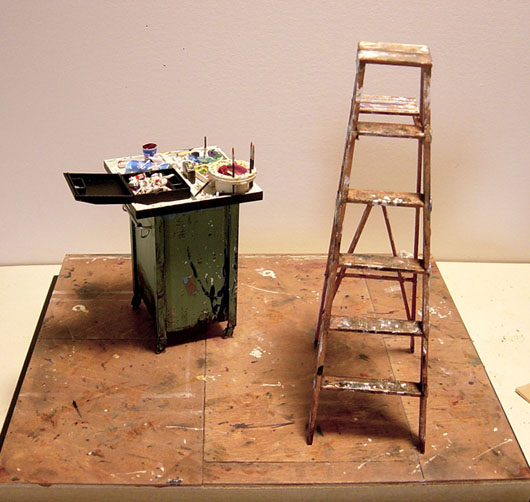 So when we look at the work of Joe Fig currently on display at Plus Ultra Gallery, what are we to think? I wrote in Ed Winkleman's blog saying I'd need to see them to determine what, if anything, made them art; Ed responded by quoting Peter Schjeldahl: "What makes these exercises art? Well, what else might they reasonably be? They perform tasks that no one assigned. They involve real work that is really gratuitous. In a world of tightly knit job descriptions, that's distinction enough."
So when we look at the work of Joe Fig currently on display at Plus Ultra Gallery, what are we to think? I wrote in Ed Winkleman's blog saying I'd need to see them to determine what, if anything, made them art; Ed responded by quoting Peter Schjeldahl: "What makes these exercises art? Well, what else might they reasonably be? They perform tasks that no one assigned. They involve real work that is really gratuitous. In a world of tightly knit job descriptions, that's distinction enough."
I'm sorry, Ed, but my definition of art is narrower than that. By Schjeldahl's definition art is anything which is difficult to do but serves no purpose; if that's the case, a lot of things are art, including watching Lost, swimming the butterfly stroke, and marriage.
What Joe's work consists of is meticulously -- one might say insanely -- detailed recreations of the studios (or parts thereof) of professional artists. They're done at standard dollhouse scale; Joe confided to me that he does even, on occasion, resort to using actual dollhouse products in his work. I guessed as much, having some experience of my own with dollhouses. For commercial products, like Poland Spring water bottles, he scans in actual product labels, prints them to scale, and glues them to the little versions he makes. Most of the stuff on view -- extension cords, cardboard boxes, tubes of paint, buckets, trash cans, blank canvases and so forth -- Joe makes himself.
I say this is insane -- in the best way, of course (Ed likes to say "We love our obsessives around here") -- but Joe seemed to find it odd when I said as much to him. He doesn't think it's insane at all to recreate, say, Fred Tomaselli's art cart and ladder at 1/12th scale, along with every drip, scuff, and scrape on the floor. He thinks, I guess, that normal people send letters to artists asking for interviews and some alone time with their work area, make drawings and measurements, take photos, go home and rebuild it one miniature object at a time.
That it's insane, or obsessive, or anyway not normal, average, or quotidian is not the same as saying that it's art. Is it? Are they? It's seeing these sculptures in a gallery which forces us to ask the question. If these were part of an exhibit at MoMA, it would be easy to know what to think of them: Not art, but about art. If they were in the Museum of Natural History, there'd be no hesitation. Not art. And I've seen similar obsessive miniature making at the Games Workshop store in Palisades Center Mall; the Warhammer tabletop gaming folks are absolutely apeshit about their figures and engines of war. Again, we can state easily: Not art; craft. But here Joe's sculptures are in an art gallery, which means we're supposed to think of them as art, and that demands some consideration.
I found myself thinking about Joe's sculptures on two distinct levels. First, certainly, Joe Fig's work is an astonishing act of craft. I will not dispute how much skilled work is involved in their creation. Joe is very talented in this regard. I'm certain that, with the right focal length and depth of field and correct positioning, you could photograph these sculptures such that they'd be indistinguishable from photos of real, full-sized places and things. I find this impressive and I don't impress easily in this regard. Joe's sculptures are truly extraordinary.
The second level is one of curiosity about how these artists work. I'm always interested in seeing how other artists do what they do. I now know, for example, that Chuck Close uses Gamblin paints. I use the same paints as Chuck Close! I now know that Eric Fischl and April Gornik have possibly the most fantastic studio space of all time. I didn't know these things before; now I do. I learned about them from Joe's sculptures.
Which at last answers my question for me. I learned something from the works, but I didn't feel anything. Are Joe Fig's sculptures art? I'm afraid I don't think they are. They are about art, they are of art. They convey information beautifully and elegantly. They are a welcome and wonderful addition to the world of art, useful and educational objects which act as excellent records of how some well-known artists of our time work. (Imagine if we had Joe Fig around to miniaturize Jan Vermeer's studio!) They are about art and artists, they are of art, they belong in an art museum. But they're not art.
Which is okay. Joe's sculptures may not be art, but they are really, really great. And the fact that they -- and their location in a gallery-- have me thinking and asking questions, that's a bonus. Which makes Joe's show better than most right there.
Enough solving the philosophical problems of the art world! Moving on to objects which ask fewer questions -- which may be more boring, but at least are easier to write about -- let's walk a little across town and stop in at Ceres Gallery to see Christine Mottau's latest paintings. Note that there's no link with her name; I couldn't find anything from her online and went to see her opening because... I'm not sure why. I just like knowing things. I consider knowing things to be a value in and of itself. And I couldn't find out what Christine's paintings looked like online, so the only way to know was to go.
![[Christine Mottau]](/blog/images/20060427/christine_mottau.jpg) It turns out Christine Mottau is something of an Abstract Expressionist. She paints fairly large. I'm going to guess about five feet high. On this Christine brushes her colors into shapes with vague intimations of natural forms; ultimately, I think, the forms suggested say more about the viewer than the viewed (I tended to see hips, breasts, flowers and trees -- no surprise there, given my predilections). Her pigments are muddy and strokes tentative at best. I'm not sure, on the evidence of these paintings, that Christine knows what she's doing any more than we do. I picture her in a trance while she paints. I don't consider this a flattering impression. The actual images reminded me very strongly of the cover illustrations of some of the old Dungeons & Dragons modules -- and not the good ones by Trampier or Erol Otus. The later ones.
It turns out Christine Mottau is something of an Abstract Expressionist. She paints fairly large. I'm going to guess about five feet high. On this Christine brushes her colors into shapes with vague intimations of natural forms; ultimately, I think, the forms suggested say more about the viewer than the viewed (I tended to see hips, breasts, flowers and trees -- no surprise there, given my predilections). Her pigments are muddy and strokes tentative at best. I'm not sure, on the evidence of these paintings, that Christine knows what she's doing any more than we do. I picture her in a trance while she paints. I don't consider this a flattering impression. The actual images reminded me very strongly of the cover illustrations of some of the old Dungeons & Dragons modules -- and not the good ones by Trampier or Erol Otus. The later ones.
Meanwhile down at Lyons Wier, Michael Lyons Wier has joined with a new partner, Anna Ortt, to form Lyons Wier • Ortt (I love a gallery name with a wacky special character in it). Anna is probably the impetus behind the current display of the work of Miki Lee, a sort of Op Art painter. (I've been seeing a lot of both Photorealism and Op Art in Chelsea for some reason.)
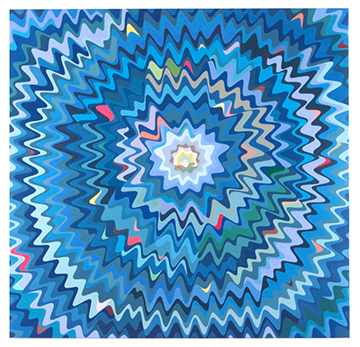 Miki's paintings didn't knock me for a loop the way some Op Art does; their effect is more subtle, like an optical illusion. A very subtle optical illusion which only moves a little bit, out of the corner of your eye. Her work is about contrasting color and clashing, curvy lines. It's all executed so carefully, though, that what reads at first as overwhelming movement quickly shows itself to be very stolid. The varying contrasts of Miki's tones read almost like a Munsell scale. Looking more closely, you can see a texture to her paint, tiny brushstrokes at times working with and then at times against the curves of the composition. This works with the gloss of the paint to lend each painting a shimmery quality in addition to the shivery feeling of the colors and shapes arguing.
Miki's paintings didn't knock me for a loop the way some Op Art does; their effect is more subtle, like an optical illusion. A very subtle optical illusion which only moves a little bit, out of the corner of your eye. Her work is about contrasting color and clashing, curvy lines. It's all executed so carefully, though, that what reads at first as overwhelming movement quickly shows itself to be very stolid. The varying contrasts of Miki's tones read almost like a Munsell scale. Looking more closely, you can see a texture to her paint, tiny brushstrokes at times working with and then at times against the curves of the composition. This works with the gloss of the paint to lend each painting a shimmery quality in addition to the shivery feeling of the colors and shapes arguing.
But at no point did I feel like there was anything else below or above this level: There's no passion or obsessive behavior here. (Passion and obsessive/compulsive tics being states which are usually taken as opposites but which can, in painting, be combined.) The main emotion I feel looking at Miki Lee's paintings is that there's no powerful emotion here. She paints these because she likes to. That's fine. I like looking at them. But, ultimately, not that much.
Next door to Lyons Wier • Ortt McKenzie Fine Art is showing Julie Allen, another artist I was seeing with no preconceptions due to the dearth of online information. In this case, though, I wasn't going for the knowing, I was going because I like Valerie McKenzie. She was so touched by my review of James Lecce's show she printed out a stack of copies of it and put it by the door of the gallery. Which I think is great. Alas, I don't think she's going to be printing out my review of Julie's show.
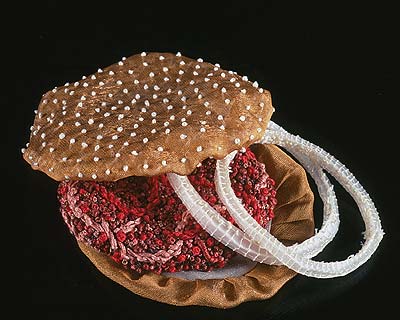 I believe that any work of art can be placed into one of three categories. After my many years of art experience, I have carefully worked out precise and descriptive terms for each of these three categories, and they are as follows: Wow!, Yuck!, and Huh?. Julie Allen's work is firmly in the last of these. I can't even formulate a decent opinion on her work because I really just have no idea what or how to think about it. This show consists almost entirely of articles of food replicated in sewn fabric. That's right: Julie has created a hamburger on a bun -- with onions! -- out of sewn and embroidered fabrics. Also a banana split, some cakes, little green peppers, mushrooms, salmon steaks, bacon, cherries, oranges, and who knows what all else.
I believe that any work of art can be placed into one of three categories. After my many years of art experience, I have carefully worked out precise and descriptive terms for each of these three categories, and they are as follows: Wow!, Yuck!, and Huh?. Julie Allen's work is firmly in the last of these. I can't even formulate a decent opinion on her work because I really just have no idea what or how to think about it. This show consists almost entirely of articles of food replicated in sewn fabric. That's right: Julie has created a hamburger on a bun -- with onions! -- out of sewn and embroidered fabrics. Also a banana split, some cakes, little green peppers, mushrooms, salmon steaks, bacon, cherries, oranges, and who knows what all else.
This is art from Venus. As an Earthling I can't even wrap my mind around it. What can it mean? Usually I'm able to at least fake some art world verbiage to explain in some fashion, however brain-damaged, why someone would want to create and display any given artwork. Not this. I don't mean to say it's bad or wrong or shouldn't have been done; not at all. It seems kind of nice. It's just... I have absolutely no frame of reference for this at all. It is what it is.
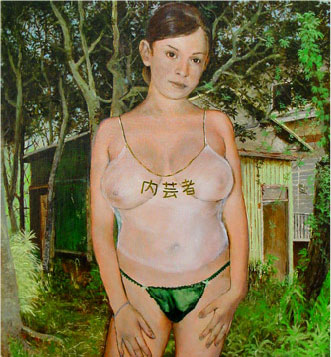 On the same floor as those two galleries I found M.Y. Art Prospects which is showing Hans Benda's "Prussian Pink Spice." I'd meant to see this show, so I'm glad the gallery happened to be open. Hans' paintings are on the small side and they often involve naked women. He also pays quite a bit of attention to the rooms and decorations behind the women. I found myself kind of wanting him to be better; I got the feeling that he stopped these paintings a little too soon, like he decided, okay, that's good enough. His works seem to stop somewhere short of full rendering. I'm not sure they'd be better if he worked on them more, but I just sort of wished he had. I get the feeling Hans is not as invested in these works -- in these women -- as he could be. Both the paintings and the women seem sloppy, disposable.
On the same floor as those two galleries I found M.Y. Art Prospects which is showing Hans Benda's "Prussian Pink Spice." I'd meant to see this show, so I'm glad the gallery happened to be open. Hans' paintings are on the small side and they often involve naked women. He also pays quite a bit of attention to the rooms and decorations behind the women. I found myself kind of wanting him to be better; I got the feeling that he stopped these paintings a little too soon, like he decided, okay, that's good enough. His works seem to stop somewhere short of full rendering. I'm not sure they'd be better if he worked on them more, but I just sort of wished he had. I get the feeling Hans is not as invested in these works -- in these women -- as he could be. Both the paintings and the women seem sloppy, disposable.
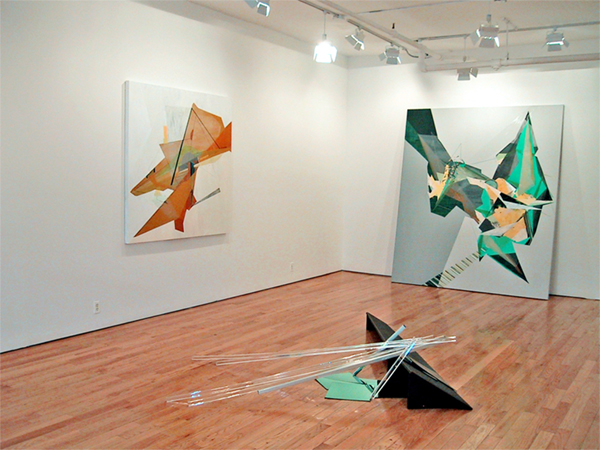 I also wandered into Priska C. Juschka Fine Art to find Dannielle Tegeder's "Smooth Shatter." Dannielle's show consists of some paintings and some sculptures, some hanging and some leaning, at various points around the room. I can't say the whole grouping did much for me; I passed through without anything touching me, which is sort of not what you'd expect from a theme like shattering glass. It was less like going through real glass and more like going through movie glass. Real glass will cut you to the bone, but movie glass just leaves harmless stuff all over the place.
I also wandered into Priska C. Juschka Fine Art to find Dannielle Tegeder's "Smooth Shatter." Dannielle's show consists of some paintings and some sculptures, some hanging and some leaning, at various points around the room. I can't say the whole grouping did much for me; I passed through without anything touching me, which is sort of not what you'd expect from a theme like shattering glass. It was less like going through real glass and more like going through movie glass. Real glass will cut you to the bone, but movie glass just leaves harmless stuff all over the place.
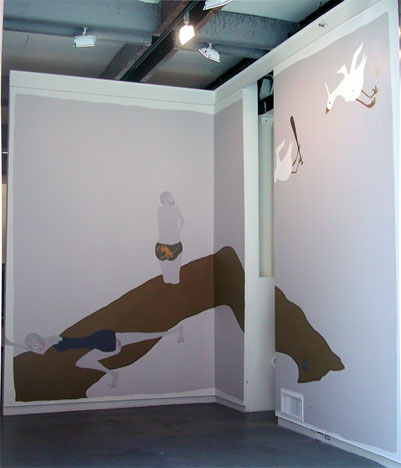 Finally escaping the clutches of 511 West 25th I crossed the street to Stux Gallery to see Thordis Adalsteinsdottir's show. Thordis's works are uncluttered acrylics in a style best described as childlike. Maybe childish. There's an element of ancient Eqyptian art here, as well as some comic book, cartoon flavor; everything's mildly disturbing in the way of art which appropriates more naive styles. Thordis herself is clearly not naive: You don't title a show full of alienation and despair "A cheerful reminder of our lives and loves" by accident. Overall I think the paintings are kind of boring, flat, and repetitive. They don't speak to me. They don't say "Here's a great painter!" or "Here's a painter who has deep feelings!" or much of anything else. They just sort of sit there looking self-indulgent, like a teenager's angsty diary pages.
Finally escaping the clutches of 511 West 25th I crossed the street to Stux Gallery to see Thordis Adalsteinsdottir's show. Thordis's works are uncluttered acrylics in a style best described as childlike. Maybe childish. There's an element of ancient Eqyptian art here, as well as some comic book, cartoon flavor; everything's mildly disturbing in the way of art which appropriates more naive styles. Thordis herself is clearly not naive: You don't title a show full of alienation and despair "A cheerful reminder of our lives and loves" by accident. Overall I think the paintings are kind of boring, flat, and repetitive. They don't speak to me. They don't say "Here's a great painter!" or "Here's a painter who has deep feelings!" or much of anything else. They just sort of sit there looking self-indulgent, like a teenager's angsty diary pages.
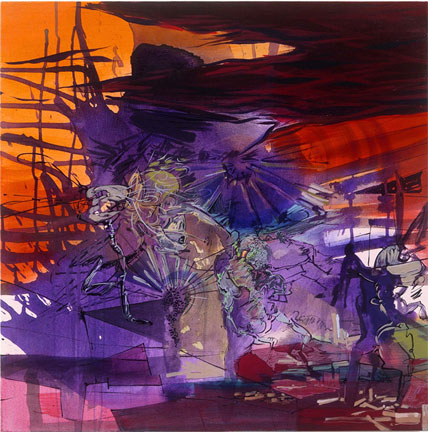 By way of contrast, Stux is showing Iva Gueorguieva in the back of the main exhibition. I didn't like her paintings a lot more than Thordis', but Iva's have the advantage of being really violent and energetic. These paintings are made of quick slashes of color and crazed squiggly lines. Forms almost appear but then vanish back into the general chaos. I'd say Iva's work looks a lot like Gerald Scarfe with Parkinson's on LSD.
By way of contrast, Stux is showing Iva Gueorguieva in the back of the main exhibition. I didn't like her paintings a lot more than Thordis', but Iva's have the advantage of being really violent and energetic. These paintings are made of quick slashes of color and crazed squiggly lines. Forms almost appear but then vanish back into the general chaos. I'd say Iva's work looks a lot like Gerald Scarfe with Parkinson's on LSD.
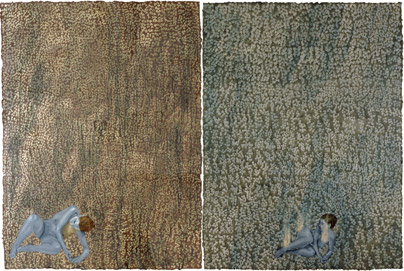 My last stop was at Lennon, Weinberg where I saw what I shall forevermore refer to as the Chicks with Dicks Show. Paul Waldman's exhibition starts off mild enough: It's titled "New Paintings and Sculptures" -- how innocuous! The first couple of paintings are mirrored pairs of what look like distressed wallpaper designs; way down in the bottom corners you can see a flowerpot, or maybe a naked woman, repeated in a slightly different pose on the second canvas. As you go from work to work, though, things very rapidly degenerate; very soon you have naked women riding other naked women and they both have penises. Maybe. Could be a strap-on, I guess. Then come a couple which are clearly not strap-ons; then, at the back of the gallery, you find a number of sculptures of, yes, chicks with dicks. Colorful, protean, masturbating, and just plain strange amalgams of man and woman, each standing about a foot tall. Then, as you circulate back to the front of the gallery, you spot the final sculpture: Low down near the ground, dark and shiny, one last penis-enhanced woman -- or is it a breast-enhanced man? -- on all fours, lifting one leg. But wait for it: Every so often, the sculpture actually urinates.
My last stop was at Lennon, Weinberg where I saw what I shall forevermore refer to as the Chicks with Dicks Show. Paul Waldman's exhibition starts off mild enough: It's titled "New Paintings and Sculptures" -- how innocuous! The first couple of paintings are mirrored pairs of what look like distressed wallpaper designs; way down in the bottom corners you can see a flowerpot, or maybe a naked woman, repeated in a slightly different pose on the second canvas. As you go from work to work, though, things very rapidly degenerate; very soon you have naked women riding other naked women and they both have penises. Maybe. Could be a strap-on, I guess. Then come a couple which are clearly not strap-ons; then, at the back of the gallery, you find a number of sculptures of, yes, chicks with dicks. Colorful, protean, masturbating, and just plain strange amalgams of man and woman, each standing about a foot tall. Then, as you circulate back to the front of the gallery, you spot the final sculpture: Low down near the ground, dark and shiny, one last penis-enhanced woman -- or is it a breast-enhanced man? -- on all fours, lifting one leg. But wait for it: Every so often, the sculpture actually urinates.
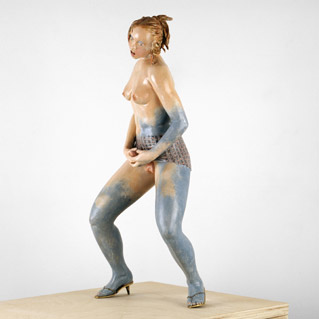 Now this is a cool show. What's better than chicks with dicks? Also, this show attracted probably the best-dressed visitors of any show I've seen. One woman turned everyone's head; if she'd been wearing less, it probably would have been less indecent. I heard one guy say to another that she was the model for the fountain. If so, I suspect Paul took some liberties with the genitalia. But you never really do know, do you?
Now this is a cool show. What's better than chicks with dicks? Also, this show attracted probably the best-dressed visitors of any show I've seen. One woman turned everyone's head; if she'd been wearing less, it probably would have been less indecent. I heard one guy say to another that she was the model for the fountain. If so, I suspect Paul took some liberties with the genitalia. But you never really do know, do you?
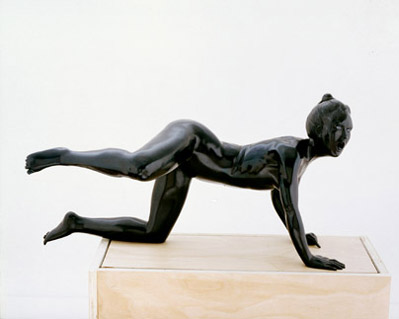 Paul's paintings are pretty excellent. I wish the reproductions online were in higher resolutions; you really can't see how detailed his little figures are, or how well executed. Paul nicely merges abstract patterns with his figuration. I'm not sure this breaks new ground -- I seem to be seeing a number of painters using a sort of figure-against-flat-background thing -- but it's done well enough to evince a chuckle or two, and it's even a little surprising. His sculptures are well-made, but a little heavy-handed for my taste. Still, a urinating fountain -- while not the most original idea of all time -- is always entertaining.
Paul's paintings are pretty excellent. I wish the reproductions online were in higher resolutions; you really can't see how detailed his little figures are, or how well executed. Paul nicely merges abstract patterns with his figuration. I'm not sure this breaks new ground -- I seem to be seeing a number of painters using a sort of figure-against-flat-background thing -- but it's done well enough to evince a chuckle or two, and it's even a little surprising. His sculptures are well-made, but a little heavy-handed for my taste. Still, a urinating fountain -- while not the most original idea of all time -- is always entertaining.
A few more of those, and the Museum of Natural History would be all set.


Hmmm, Miki Lee! I love her work. The gallery has shown her a few times... before the new partnership.Wish I could afford her work!